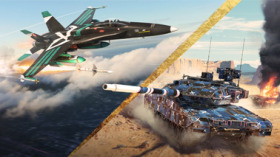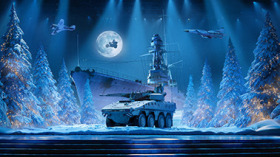
- For PC
- For MAC
- For Linux
- OS: Windows 10 (64 bit)
- Processor: Dual-Core 2.2 GHz
- Memory: 4GB
- Video Card: DirectX 11 level video card: AMD Radeon 77XX / NVIDIA GeForce GTX 660. The minimum supported resolution for the game is 720p.
- Network: Broadband Internet connection
- Hard Drive: 22.1 GB (Minimal client)
- OS: Windows 10/11 (64 bit)
- Processor: Intel Core i5 or Ryzen 5 3600 and better
- Memory: 16 GB and more
- Video Card: DirectX 11 level video card or higher and drivers: Nvidia GeForce 1060 and higher, Radeon RX 570 and higher
- Network: Broadband Internet connection
- Hard Drive: 62.2 GB (Full client)
- OS: Mac OS Big Sur 11.0 or newer
- Processor: Core i5, minimum 2.2GHz (Intel Xeon is not supported)
- Memory: 6 GB
- Video Card: Intel Iris Pro 5200 (Mac), or analog from AMD/Nvidia for Mac. Minimum supported resolution for the game is 720p with Metal support.
- Network: Broadband Internet connection
- Hard Drive: 22.1 GB (Minimal client)
- OS: Mac OS Big Sur 11.0 or newer
- Processor: Core i7 (Intel Xeon is not supported)
- Memory: 8 GB
- Video Card: Radeon Vega II or higher with Metal support.
- Network: Broadband Internet connection
- Hard Drive: 62.2 GB (Full client)
- OS: Most modern 64bit Linux distributions
- Processor: Dual-Core 2.4 GHz
- Memory: 4 GB
- Video Card: NVIDIA 660 with latest proprietary drivers (not older than 6 months) / similar AMD with latest proprietary drivers (not older than 6 months; the minimum supported resolution for the game is 720p) with Vulkan support.
- Network: Broadband Internet connection
- Hard Drive: 22.1 GB (Minimal client)
- OS: Ubuntu 20.04 64bit
- Processor: Intel Core i7
- Memory: 16 GB
- Video Card: NVIDIA 1060 with latest proprietary drivers (not older than 6 months) / similar AMD (Radeon RX 570) with latest proprietary drivers (not older than 6 months) with Vulkan support.
- Network: Broadband Internet connection
- Hard Drive: 62.2 GB (Full client)

F7F-3 in military camouflage
 |
 |
 |
How can you get this vehicle? (view calendar task)
← return to action announcement
The F7F-3 Tigercat from testing ground “113” is further development of the US Navy twin-engine fighter, the F7F. The third modification is equipped with more powerful engines which allowed for the installation of unguided rockets and even three Tiny Tims, which were effective not only against ships, but also enemy bases. Although the original F7F could reach a very high speed for a twin-engine fighter, this new machine accelerates even faster both in level flight and in a dive, which makes it an excellent aircraft for “hit and run” tactics. Like the original Tigercat, the F7F-3 has four 20mm guns AN/M2 and four 12.7mm machine guns “Browning M2” - a powerful arsenal with a fire rate of almost 8 kg of lead per second!
After testing, some of the experimental markings have been left behind on some of the surfaces and engines. The aircraft is fully equipped with all the latest modifications and has a premium status.
|
Information, tactical and technical characteristics (AB/RB) |
Get a "pin-up" decal by completing of tasks for pilots. |
|||||||||||||
|
 |
The F7F-3 Tigercat in history
The Grumman company continued to work on the F7F after it entered service. The third variant of the aircraft was a very deep modernization of the original, although visually the only difference was a bigger tail section (this resulted in a much better stability during flight). On the other hand, the biggest change was the introduction of the more powerful “Pratt & Whitney” R-2800-34W engines with a power output of 2,100 HP, which allowed for better flight characteristics in the Tigercat at high altitude.
Acceleration and climb rate increased, while the powerful weapons in the nose of the aircraft, consisting of four 20mm guns and four 12.7mm machine guns, remained. This fighter could carry rockets, which made it more universal and effective in attacking both ground and sea targets.
This aircraft was in production from March 1945 till June 1946 and during this time 250 units were built.



